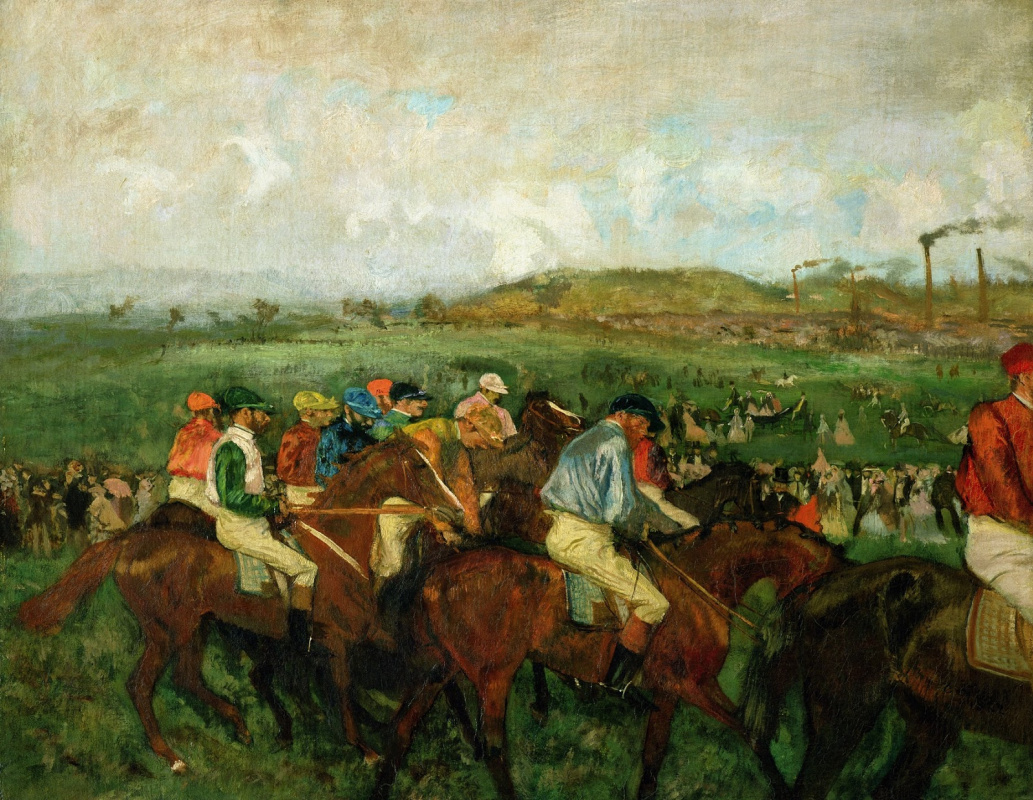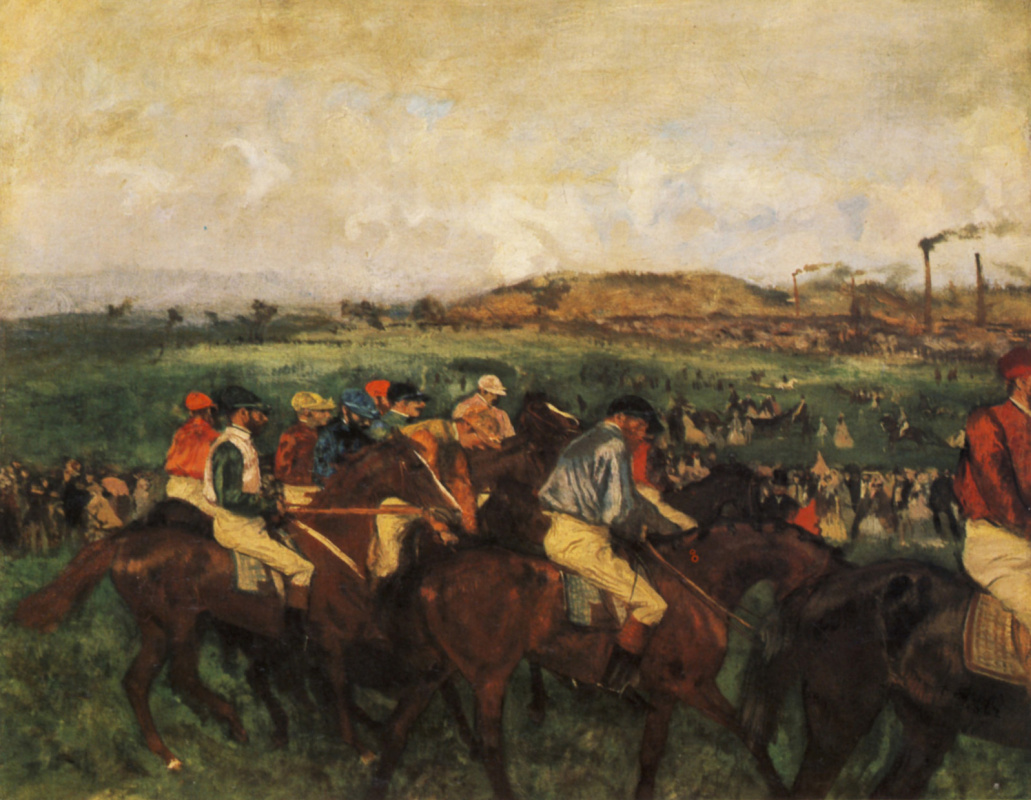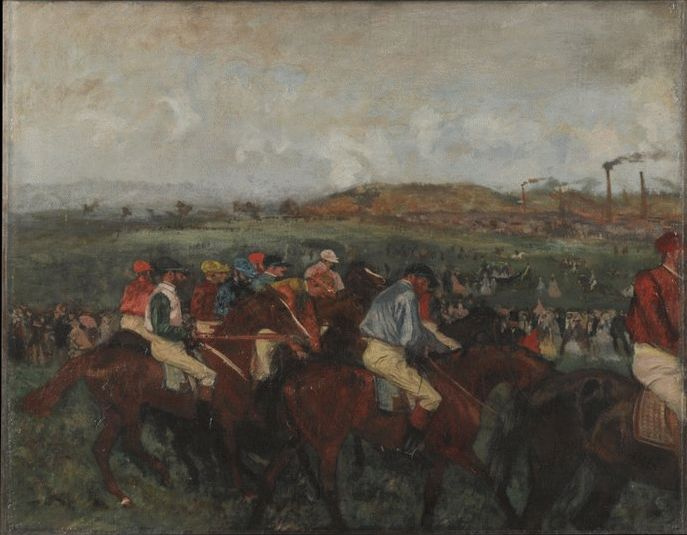log in
Enter site
Login to use Arthive functionality to the maximum
Riders before the start
Edgar Degas • Pintura, 1862, 48.5×61.5 cm
Descripción del cuadro «Riders before the start»
In 1857, during a massive reorganization of Paris under Baron Haussmann, it opens the first Racecourse. It is located in the Bois de Boulogne, the favorite place of walks of the capital's aristocracy and secular lions, and is called "Longchamp". Jump, along with sailing, become a fashionable passion of the French, who carried on the racetrack all the free time.
Edgar Degas admired the horse, but even more impressed by jockeys. Because it's concentrated and puzzling challenge to his eternal desire to capture movement, intermediate, elusive, awkward and unexpected moments, of which it is composed.
Degas began to write the movement of horses and jockeys, even before it was a funny, historical and one of the most important in the history of painting and film debate: politician, founder of Stanford University, the owner of the railway and steamship U.S. companies Leland Stanford once had an argument with two acquaintances. He claimed that the horse while running, the tears in some moments all 4 feet off the ground. His opponents claimed that one leg is definitely the land concerned, at any time running. Stanford hires photographer Edward Meybridzha known stories from the Antarctic to the built fotogram" and proved the correctness of his statements. After Maybridge installed along the track 12 cameras, attached to each thread, after the horse, meshing during the running of the filament, led cameras, Stanford managed to win the bet. And Meybridzha is to create chronophotography. After this experiment, he began to use it for shooting 24 camera, filming the movement of animals and people and has published several books with time-lapse shots of these processes.
Degas bought a book Meybridzha immediately when it came out in France. But most of the paintings jockey cycle was already written before – made Meybridzha "electrophotographic investigation of consecutive phases of the movement only confirmed the observations of the artist, who spent every weekend at the track.
Picture "Gentlemen at the races" Degas wrote in the two approaches, with a difference in 20 years – and a late correction made in 1882, was only the clothing of jockeys and the distant landscape overgrown with time, urban signs, factory chimneys. The figures of horses and riders, the artist had nothing to add even after 20 years – it was a picture of extreme precision. However, as always with Degas.
Author: Anna Sidelnikova
Edgar Degas admired the horse, but even more impressed by jockeys. Because it's concentrated and puzzling challenge to his eternal desire to capture movement, intermediate, elusive, awkward and unexpected moments, of which it is composed.
Degas began to write the movement of horses and jockeys, even before it was a funny, historical and one of the most important in the history of painting and film debate: politician, founder of Stanford University, the owner of the railway and steamship U.S. companies Leland Stanford once had an argument with two acquaintances. He claimed that the horse while running, the tears in some moments all 4 feet off the ground. His opponents claimed that one leg is definitely the land concerned, at any time running. Stanford hires photographer Edward Meybridzha known stories from the Antarctic to the built fotogram" and proved the correctness of his statements. After Maybridge installed along the track 12 cameras, attached to each thread, after the horse, meshing during the running of the filament, led cameras, Stanford managed to win the bet. And Meybridzha is to create chronophotography. After this experiment, he began to use it for shooting 24 camera, filming the movement of animals and people and has published several books with time-lapse shots of these processes.
Degas bought a book Meybridzha immediately when it came out in France. But most of the paintings jockey cycle was already written before – made Meybridzha "electrophotographic investigation of consecutive phases of the movement only confirmed the observations of the artist, who spent every weekend at the track.
Picture "Gentlemen at the races" Degas wrote in the two approaches, with a difference in 20 years – and a late correction made in 1882, was only the clothing of jockeys and the distant landscape overgrown with time, urban signs, factory chimneys. The figures of horses and riders, the artist had nothing to add even after 20 years – it was a picture of extreme precision. However, as always with Degas.
Author: Anna Sidelnikova








